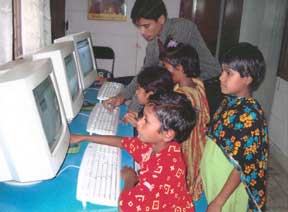Foundations and Assessment of Education/Edition 1/Foundations Table of Contents/Chapter 6/Chapter FAQ

Learning Targets:
Readers should be able to define technology integration and provide at least four examples of technolology integration in the classroom.
Given descriptions of each, readers should be able to identify both magnet schools and charter schools.
Readers should be able to define school vouchers and provide an argument either for or against them.
Readers should be able to list at least one pro and one con of homeschooling.
Readers should be able to identify the standards of the No Child Left Behind Act.
Technology Integration[edit | edit source]
|
|
What is Technology Integration?
Technology Integration is the use of technology resources, such as computers, software applications, the Internet, cameras, etc., in daily classroom practices. Technology must be routine and apparent for integration in the classroom to be achieved. Using technology as a resource in the classroom helps the student to blend their learning techniques (Bledsoe, 2008). When integration is used, students seem to more actively engage themselves in the learning process. Technology Integration in the classroom requires reshaping, redesigning, and re-visioning traditional teaching and learning relationships (Georgina and Olson, 2008). What are some types of technology integration? Along with computers and software programs, there are several different ways that teachers integrate technology into the classroom. Below are a few examples along with a description of each.
Podcast: a program, as of music or talk, made available in digital format over the Internet (Merriam Webster, 2009).
PowerPoint Presentation or Slideshow: a display of a series of chosen words and/or pictures done for artistic or instructional purposes (Merriam Webster, 2009).
IPOD: a pocket size device used to play music files (Merriam Webster, 2009).
Instant Messaging: a means or system for transmitting electronic messages instantly (Merriam Webster, 2009).
Webcam: a camera used in transmitting live images over the World Wide Web (Merriam Webster, 2009).
To learn more about technology integration, visit the following links:
Magnet Schools and Charter Schools[edit | edit source]
What is a magnet school and what does it offer?
A magnet school is part of the public school system and exists outside of zoned school boundaries. Instead of attending the school they are closest to, students may choose to attend a magnet school. Magnet schools attract students because they generally have something special to offer over a regular school, which makes attending them an attractive choice to many students. Most Magnet Schools concentrate on a particular area of study, and offer an alternative mode of instruction (Rossell, 2005).
What is a charter school and what does it offer?
A charter school is a publicly funded school that has been granted a charter (a document outlining its terms and conditions) exempting it from selected state or local rules and regulations. It is a new, innovative public school that is accountable for student results. It delivers programs for educational excellence and the needs of the community. A school's charter is reviewed every three to five years and can be revoked if certain guidelines are not met (National Education Association, 2009).
To learn more about magnet schools and charter schools, visit the following links:
http://www.ed.gov/parents/schools/choice/definitions.html
Vouchers[edit | edit source]
What is a voucher?
A voucher is a coupon that is issued by the government to a parent or guardian in financial need that is to be used to fund a child's education in either a public or private school (Merriam Webster, 2009). With a voucher, parents can pay for the education of their child at the school of their choice, rather than the public school to which they are assigned.
Why is there controversy surrounding vouchers?
Vouchers are a subject of heated controversy because there are many variables to be considered. The main question that arises is who should receive school vouchers? Should specific groups be targeted, or is every child eligible?
What are the supporting arguments for vouchers?
Supporters of school vouchers believe that parents should be given the right to choose the best educational environment for their children. Advocates argue that vouchers would give all parents, regardless of their socioeconomic status, the opportunity for their child to receive a better education (Costrell, 2009). By making the educational system afree market enterprise, the public educational system would then be forced to provide a higher level of education to compete with other schools. Supporters also state that school vouchers would bring more diversity and equality into the schools, as there would be students from all races and backgrounds attending. (Bolick, 2008).
What are the opposing arguments for vouchers?
One central argument against vouchers is that they violate the first amendment, specifically the separation of church and state. Private schools are predominantly religious institutions, which makes any government funding to these schools a violation of the first amendment. (Bolick, 2008). Opponents also argue that there is no need for school vouchers because public schools are generally on equal footing with private schools. When completing the same coursework, opponents say that students perform equally in both institutions. Because of this, they argue that there is no need for the public to send any child to a private school. Another argument is that the voucher program will drain money from the schools that need it most, and public schools may become dumping schools for the difficult to handle (Costrell, 2009).
To learn more about vouchers, visit the following links:
http://en.wikipedia.org/wiki/School_voucher
Homeschooling[edit | edit source]
What is homeschooling?
Homeschooling is to teach (one's children) at home. (Merriam Webster, 2009), and also means to be taught in a particular culture. With homeschooling, the parent is the teacher and along with academics, they can teach certain philosophies to their children that they believe are valuable. What is the government's role in homeschooling?
Virginia state law requires that a homeschooling parent meet at least one of four specific requirements. Virginia Code 22.1-254.1 outlines these four requirements: The teaching parent holds a high school diploma. The teaching parent meets the qualifications for a teacher prescribed by the Board of Education. The teaching parent provides a program of study or curriculum which may be delivered through a correspondence course or distance learning program or in any other manner. The teaching parent provides evidence that the parent is able to provide an adequate education for the child (The Virginia Department of Education , 2008).
What are the pros of homeschooling?
Homeschooling is valued by many parents for a variety of reasons. Parents are able to teach their children academic material as well as values, beliefs and philosophies. Children can also be taught at their own pace, and can sometimes accomplish more in a few hours than what a regular classroom can accomplish in one week. Homeschooling provides the child with educational, emotional and physical freedom (Shaw, 2009) .
What are the cons of homeschooling?
Homeschooling is not for everyone. There may be time restraints on the family, as learning outside of a school environment can consume valuable time. There may also be financial restraints, as there is often at least one unemployed parent with the time and ability to homeschool. There are limited sports and other extracurricular activities for the child to participate in, which are important for the socialization of the child. A homeschooling family must be willing to live outside the box (Shaw, 2009). To learn more about homeschooling, visit the following links:
http://school.familyeducation.com/home-schooling/parenting/29861.html
The No Child Left Behind Act (NCLB)[edit | edit source]
What is the No Child Left Behind Act (NCLB)?
The No Child Left Behind Act of 2001 was signed into law in January 2002 by President Bush. It is a federal law to improve education for all children. This law challenges states and school districts to improve the academic achievement of public schools considered to be at risk for failure (US Department of Education, 2009).
What are the standards of the NCLB?
There are four main standards, or pillars, of the No Child Left Behind Act. They are: stronger accountability for results, more freedom for states and communities (Under NCLB, states and schoold districts have unlimited flexibility in how they use federal education funds), proven education methods, and more choices for parents (US Department of Education, 2009).
Why is there controversy behind the NCLB?
There are teachers, schools, and educational organizations that believe the No Child Left Behind Act is flawed. Money concerns are a main factor, as adequate funding to support this law is essential. Another issue leading to this controversy is the fact that some teachers feel the need to sacrifice one subject for another under the NCLB testing requirements. Some believe that under the NCLB act the federal government may have too much control, and some changes may need to be implemented.(How to Fix, 2007).
To learn more about the No Chid Left Behind Act, visit the following links:
http://time.com/time/magazine/article/0,9171,1625192-4,00.html
Multiple Choice Questions[edit | edit source]
1. Which of the following is not a form of technology integration in the classroom?
A) Nintendo
B) Podcast
C) Powerpoint
D) Webcam
2. Which of the following is not an opposing argument for vouchers?
A) Public schools and private schools are generally on equal footing
B) Vouchers would give all parents the opportunity for their child to receive a better education
C) Vouchers violate the first amendment
D) Vouchers will drain money from the schools that need it most
3. Mrs. Smith wants to send her son Billy to a type of school that offers a specialized curriculum in performing arts. What type of school should she choose?
A) Charter School
B) Magnet School
C) Private School
D) Public School
4. Mrs. ODell is concerned that under the No Child Left Behind Act, she will not be able to spend as much time on environmental education than on reading and math. What is the source of this controversy?
A) Money concerns
B) Necessary Changes
C) Sacrificing one subject for another
D) Too much federal control
Answers to Multiple-Choice Questions 1. A 2. B 3. B 4. C
References[edit | edit source]
Georgina, David A. and Olson, Myrna R. (2008). Integration of Technology in Higher Education: A Review of Faculty Self-Perceptions. The Internet and Higher Education, 11(1), pp. 1–8
Bledsoe, G. L.(2008). Technology Taxonomy. Retrieved May 27, 2009 from the Nationl Education Association Web Site: http://www.nea.org/teachexperience/gb050201.html
National Education Association. (2008). Charter schools. Retrieved May 27, 2009 from http://www.nea.org/charter/index.html
Rossell, C.H. (2005). Whatever Happened toâ¦Magnet Schools? Education Next, 5(2), pp. 44–49
Costrell, Robert M. (2009). Who Gains, Who Loses? Education Next, 9(1), pp. 62–69.
Vouchers. 2009. In Merriam-Webster Online Dictionary. Retrieved May 30, 2009, from http://www.merriam-webster.com/dictionary/vouchers
Podcast. 2009. In Merriam-Webster Online Dictionary. Retrieved May 30, 2009, from http://www.merriam-webster.com/dictionary/podcast
Slideshow. 2009. In Merriam-Webster Online Dictionary. Retrieved May 30, 2009, from http://www.merriam-webster.com/dictionary/slideshow
IPOD. 2009. In Merriam-Webster Online Dictionary. Retrieved May 30, 2009, from http://www.merriam-webster.com/dictionary/IPOD\
Instant Messaging. 2009. In Merriam-Webster Online Dictionary. Retrieved May 30, 2009, from http://www.merriam-webster.com/dictionary/instantmessaging
Webcam. 2009. In Merriam-Webster Online Dictionary. Retrieved May 30, 2009, from http://www.merriam-webster.com/dictionary/webcam
Homeschooling. 2009. In Merriam-Webster Online Dictionary. Retrieved May 30, 2009, from http://www.merriam-webster.com/dictionary/homeschooling
Bolick, C. (2008). Voting Down Vouchers: Lessons Learned from Utah. Education Next, 8(2), pp. 46–51
The Virginia Department of Education. (2008). Home Instruction in Virginia: Information for Parents 2008-2009. Retrieved May 31, 2009, from The Virginia Department of Education: http://www.doe.virginia.gov/VDOE/Parents/homeinst.pdf
How to fix No Child Left Behind (2007,May 24). TIME. Retrieved on May 27, 2009 from http://time.com/time/magazine/article/0,9171,1625192-4,00.html
The Center for Education Reform http://www.edreform.com/
U.S. Department of Education http://www.ed.gov/
Shaw, Isabel. (2009). The Pros and Cons of Homeschooling. Retrieved May 30, 2009 from Family Education: http://school.familyeducation.com/home-schooling/parenting/29861.html
 |
Rate This! |  |


